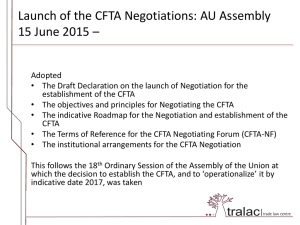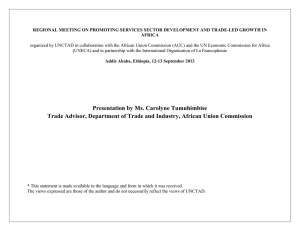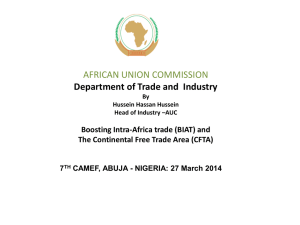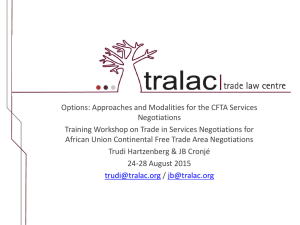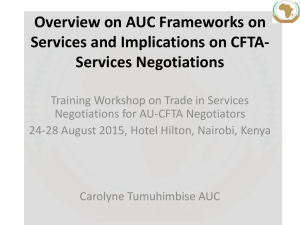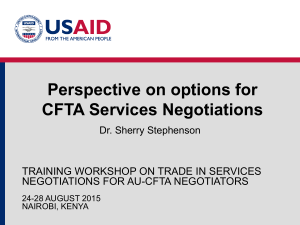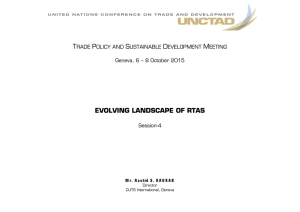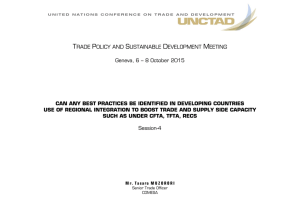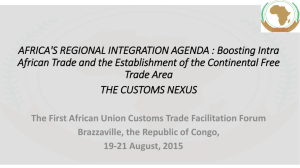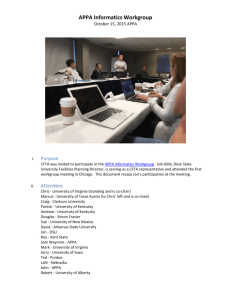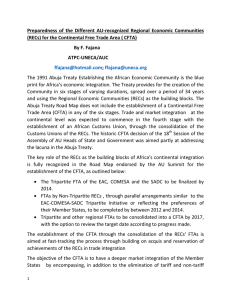Scope of the CFTA Negotiations, Principles, Objectives and Institutional Framework Prudence Sebahizi
advertisement
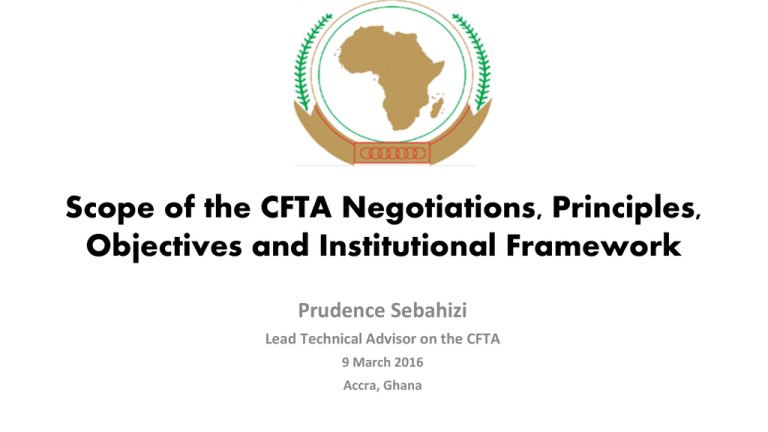
Scope of the CFTA Negotiations, Principles, Objectives and Institutional Framework Prudence Sebahizi Lead Technical Advisor on the CFTA 9 March 2016 Accra, Ghana Outline 1. 2. 3. 4. 5. 6. 7. 8. 9. 10. Why the CFTA? Background The Road Map for Establishment of the CFTA Objectives of the CFTA The CFTA Negotiating Principles Negotiating Structure and Stakeholders Participation The Scope of the CFTA Progress Made Challenges Recommendations Why The CFTA? •As Kenya’s President Uhuru Kenyatta passionately put it: “There cannot be a good reason why it is easier for us to trade with Asia, Europe and the Americas, rather than with fellow Africans.” •“The CFTA is critical NOT ONLY for its potential benefits, BUT ALSO to mitigate the costs associated with inaction”. - UNCTAD Why The CFTA? (Cont’d…) Africa is the world’s poorest and most underdeveloped continent with a continental GDP that accounts for just 2.4% of global GDP. Africa has approximately 30% of the earth’s remaining mineral resources. The Continent has the largest reserves of precious metals with over 40% of the gold reserves, over 60% of cobalt, and 90% of platinum reserves. Why The CFTA? (Cont’d…) Intra- African trade is about 12%. In North America it is 40%, and 63% between countries in Western Europe, 30% in ASEAN; Key to improving low intra-African Trade The CFTA will bring 54 countries with combined population of over 1 billion people and combined GDP of USD3.4 trillion. Why The CFTA? (Cont’d…) Africa's biggest economies trading on MFN basis Better terms when exporting overseas under such programs as EPAs, AGOA, GSP Africa remains 3% of global trade and DDA at the WTO, AGOA, EPAs have not enabled Africa’s successful integration into the Global Economy Europe and USA are major destination for African products, Asia and China are becoming more important; Why The CFTA? (Cont’d…) Positioning Africa to benefit: • Many of Africa’s 54 countries are small, with populations of fewer than 20 million and economies of less than $10 billion. • National markets are therefore too small to justify investments, since both adequate supply of inputs and sufficient client bases (demand) remain too expensive or out of reach. CFTA as a tool for Structural Transformation • Dynamic impact of increased trade among African countries for industrial development, better infrastructure connectivity, economies of scale, enhanced competitiveness and structural transformation. Why The CFTA? (Cont’d…) Achieving the African Economic Community under the Abuja Treaty of 1991 • The Treaty provides for establishment of African Economic Community through the following stages: • Strengthening of Regional Economic Communities; • Establishment of a Continental Customs Union; • Implementation of Common Sector Policies; and • Establishment of a Continental Common Market and ultimately African Economic Community. Background: The Continental Free Trade Area (CFTA) • The Continental Free Trade Area (CFTA) initiative is in line with the Abuja Treaty (signed on 3rd June 1991) – the Treaty Establishing the African Economic Community. • That’s why the January 2012 Summit of Heads of States and Government endorsed the Action Plan on Boosting Intra African Trade (BIAT) and decided on the establishment of a Continental Free Trade Area by an indicative date of 2017. Background: CFTA Framework June 2015 Summit Launched the Negotiations Adopted Decision and Declaration launching the negotiations • Endorsed the following documents: • The Negotiating Principles for the CFTA • Institutional Arrangements for the CFTA negotiations • The Terms of Reference for the CFTA-NF • The Indicative Roadmap for the CFTA negotiations. CFTA Road Map (Timelines) The Assembly 18th Ordinary Summit in January 2012, decided that the CFTA should be operationalized by the indicative date of 2017, with the following milestones: Finalization of the EAC- COMESA-SADC Tripartite FTA initiative by 2014; The four other AU-recognized RECS (ECOWAS, CEN-SAD, ECCAS and UMA), to negotiate a parallel FTA – should they wish to do so, by 2014. They could also choose to join the CFTA directly Consolidation of the Tripartite and other regional FTAs into a Continental Free Trade Area (CFTA) initiative between 2015 and 2016; Establishment of the Continental Free Trade Area (CFTA) by 2017 with the option to review the target date according to progress made. The CFTA Negotiations Roadmap RATFICA FINLSE TION AGMNT RATIFICATION ENTRY INTO FORCE DEC 2017 Oct 2017 FINISH NEG FINALISATION PHASE LEGAL SCRUBBING SIGNATURE TR TT Ro O Apr 2016 2nd NF Feb 2016 START NEG JUNE 2015 LAUNCH Objectives of the CFTA Achieve a comprehensive and mutually beneficial trade agreement among the Member States of the African Union. • Enhance competitiveness at all levels and more specifically at the industry and enterprise level through exploiting opportunities for scale economies, reducing business costs, continental/global market access and better reallocation of resources including through the development of trade-related infrastructure; • To overcome dependence on exportation of primary products and promote social and economic transformation for inclusive growth, industrialization and sustainable development in line with Agenda 2063; • Resolve the challenges of multiple and overlapping memberships and expedite the regional and continental integration processes; Objectives of the CFTA (Cont’d) • Realize the potential to expand and accelerate the growing diversification and dynamism of intra-African trade including the aim to increase by 50 % trade among African countries by 2022 through better harmonization, coordination and implementation of trade liberalization and facilitation regimes and instruments across RECs and across Africa in general; and • In the context of boosting intra-Africa trade and realizing the transformational potential of increased trade among African countries, to create a freer market for goods and services, building upon the trade agreements within the regional economic communities and associated commitments and thus pave the way for accelerating the establishment of the Continental Customs Union; The CFTA Negotiating Principles The Continental Free Trade Area negotiation process shall be guided by the following overarching principles: • i) The CFTA negotiations shall be AU Member States/RECs/Customs Territories driven with support of the African Union Commission and its structures. • ii) RECs FTAs as building Blocs for the CFTA • iii) Reservation of Acquis • iv) Variable geometry The CFTA Negotiating Principles…..Cont’d • v) Flexibility and Special and Differential Treatment • Vi) Transparency and disclosure of information • vii) Substantial liberalisation • viii) MFN Treatment • ix) National Treatment • x) Reciprocity • xi) Decisions shall be taken by consensus. • xii) Adoption of Best Practices CFTA Negotiating Structure Assembly of Heads of States and Government (HATC) African Union Ministers of Trade (AMOT) Committee Senior Officials CFTA-Negotiating Forum (CFTA-NF) Stakeholders Participation Technical Working Groups (TWGs) Continental Task Force Scope of the CFTA Trade in goods • • • • • • • • • • • • Trade in Services Tariff liberalization, • Transportation NTBs, • Air, maritime RoO, • Financial Services Trade Facilitation • banking, • Customs cooperation • Harmonization of Doct • insurance, Transit & Transit facilities, • Tourism, Trade remedies, • Energy, Safeguards Standards, Technical Barriers 2 Trade Sanitary and phytosanitary Dispute settlement Institutional arrangements Other Issues • Competition policy • Intellectual Property Rights, • Investment • Movement of business persons, Phase I: Trade in goods and trade in services will be negotiated concurrently. Phase II: Other Issues (Investment, IPR, Competition Policy) Africa We Want: AU Agenda 2063 Boosting IntraAfrican Trade – BIAT 1. A prosperous Africa based on inclusive growth and sustainable development Trade Policy 2. An integrated continent, politically united and based on the ideals of Pan Africanism and the vision of Africa’s Renaissance Trade Facilitation 3. An Africa of good governance, democracy, respect for human rights, justice and the rule of law Productive Capacity 4. A peaceful and secure Africa Trade Related Infrastructure 5. An Africa with a strong cultural identity, common heritage, values and ethics 6. An Africa where development is people-driven, unleashing the potential of its women and youth 7. Africa as a strong, united and influential global player and partner. Trade Finance Trade Information Factor Market Integration Continental Free Trade Area – CFTA AIDA, PIDA, CAADP, Etc. Trade in Goods Agricultural Transformation Trade in services Food Security Investment Energy Intellectual Property Rights Transport Competition Policy ICT Industrial Development Water Resources Cat A Champions Cat C TFTA Bilateral Cooperation among RECs Cat D Continental Customs Union Advanced RECs African Economic Community Cat B African union Agenda 2063 Principle of Variable Geometry: Member States Driven Continental FTA Cascaded Approach to CFTA Negotiations Principle of Acquis: RECs Driven/Builing Blocs Common Denominator for All RECs as the Baseline for CFTA Agreement: This will apply to all 54 AU Member States – Consolidation of RECs Acquis by AUC Progress Made • Preparatory Studies • Capacity Building Activities • Inaugural Meeting of the CFTA Negotiating Forum • Ongoing work on Drafting the CFTA Model Agreement • Stakeholders Consultations Key Challenges • Commitment to integration varies across countries. • Some countries have not undertaken any liberalization within their respective RECs FTA. • Accordingly if they cannot commit themselves to a smaller FTA, it will be difficult for them to commit to a CFTA. • Some countries also remain skeptical of regional integration fearing domination by richer or more powerful states or ceding power to a supranational body. Recommendations • Emphasize the Role of RECs in the CFTA process: Coordination of Member States Positions; Address Capacity Issues; Create Awareness; Engagement of stakeholders. • Promoting free movement of people as an important ingredient of cross border trade. • Involvement of key stakeholders: Through closer collaboration between the AUC and RECs, the private sector and member states, the engagement of civil society, parliamentarians, and the private sector through innovative means, we foresee a different approach and outcomes for the CFTA. • An advocacy and communication strategy has been developed to ensure that there is a buy in from all these stakeholders, so that they can play their respective roles in this critical process. “It was a dream of our founding fathers to create a continent where people can move freely (with) goods and services across the continent. Fast tracking the creation of a CFTA is the way to go”. - H.E Mr. John Dramani Mahama, President of the Republic of Ghana Thank You
